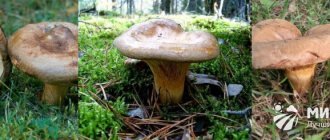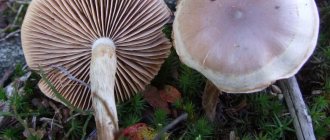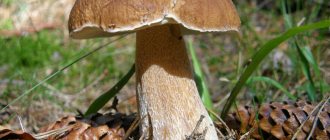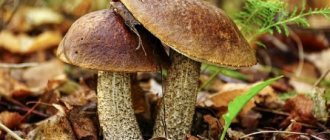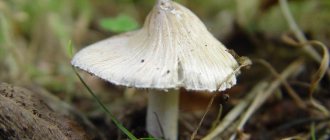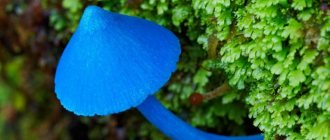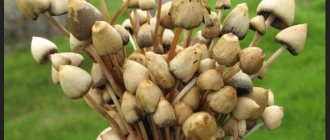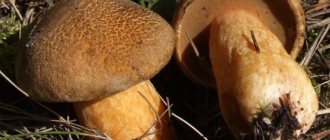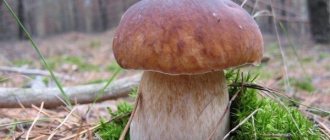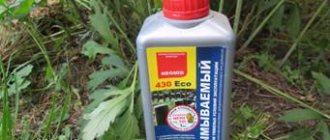Short description
| Type of mushrooms: | Conditionally edible |
| Other names (synonyms): | Goby, Kulbik, Snotty and Fist. |
| Latin name: | Russula foetens |
| Family: | Russula |
| Distinctive feature: | Valuy is considered conditionally edible, in particular because of its unpleasant odor, but in Russia, it is traditionally salted, the mushrooms are first peeled and the bitterness is removed by soaking or boiling, and then eaten. |
| Beginning of the season: | June |
| End of season: | October |
| Leg height (cm): | 6—12 cm |
| Cap width (cm): | 8—12 (up to 15) cm |
| Smell: | rancid, oily, and becomes more like rotting fish as it ages. |
| Taste: | unpleasant and quite caustic. |
| Tasting score: | [kkstarratings] Have you tried this mushroom? Then rate it! |
| Hat: | at first semi-spherical, almost spherical, with an edge pressed to the stem, mucous, then convex with a drooping ribbed edge, sticky, later convex-prostrate, sometimes prostrate and depressed towards the middle, tuberculate-curved, with a strongly ribbed, furrowed and sometimes cracked edge, dry or slightly sticky, yellow-brown, red-brown, ocher-brown with a lighter edge, often eaten away by insects and slugs. |
| Leg: | cylindrical or barrel-shaped, white, often covered with brown spots, especially near the base. With age, an irregularly shaped cavity forms in the middle of the stalk, and the stalk, which is relatively strong at the beginning, later becomes very loose. |
| Hymenophore (bottom of cap): | the plates are at first white, later creamy, many forked. |
| Disputes: | warty, amyloid, 8.5×8 µm. |
| Pulp: | white in color, fragile consistency, gradually darkens at the cut site. |
| Natural environment and mycorrhiza: | in coniferous and mixed forests, especially under spruce and beech trees, rarely other deciduous trees, on moist soils. |
| False doubles: | Russula laurocerasi – distinguished by the smell of bitter almonds. Russula subfoetens gives a yellow color to the pulp under the influence of alkali solutions; valui does not give such a reaction. Russula illota – distinguished by yellow plates with dark, to violet-brown, edges; its smell is more like bitter almond. |
| Growing: | – |
| Use: | conditionally edible mushroom, used salted and pickled after soaking for 2-3 days and boiling for about 20-25 minutes. |
| Medicinal properties: | – |
| Spreading: | in forests in Eurasia and North America, in Russia it is most common in the European part, the Caucasus, Western Siberia and the Far East. |
For lovers of quiet hunting, there are few mushrooms that have so many affectionate nicknames. Valuy, despite its conditional edibility, is very popular. It is not only very interesting to collect, but also pleasant to cook. Valui are delicious in any form; they are perfectly preserved for the winter. Find out everything about this mushroom, how and where to collect it, how to identify valuuy, and what can be prepared from it.
Description of the mushroom
Valuy belongs to the genus Russula of the Russula family. It also has other names: mushroom Goby, Svinur, Kulbik, Soplivik, Soplivchik, mushroom Kulachok (Fist), Plakun, Kubar, Podtopolnik, Cowhouse, Svinushka. Latin name - Russula foetens.
The cap of the valuuya does not exceed 12–15 cm in diameter, yellow or yellowish-brown. In young specimens, the upper part is convex, spherical, and as the mushroom matures it almost completely opens. In adult mushrooms, a pronounced depression appears in the center; radial grooves can be seen along the edges.
The skin of the cap is shiny and smooth, slimy, and comes off easily. It was this property that gave the name to the mushroom: snotty, slobbery, weeping.
The hymenophore (lower part of the cap) is lamellar. The plates are narrowly adherent and have a whitish or dirty cream color. The milky sap that exudes from the pulp may darken over time and leave brown spots.
Barnhorn has very fragile white flesh, which can turn brown as the mushroom ages. It has a slightly bitter, burning taste, the smell of spoiled oil, and becomes more intense in adult representatives of the species.
Important! Valui belong to the category of conditionally edible mushrooms, which means that they cannot be consumed raw. It is imperative to soak for a long time and boil several times.
The leg of the barn is characterized by a barrel-shaped or cylindrical shape, the height of this part varies from 12 to 15 cm, diameter from 1.5 to 3.5 cm. Its color differs from the tone of the cap, it is lighter, and turns brown towards the base. In older mushrooms, a cavity and a pronounced loose structure appear inside the stem.
Edibility of Goby
Valuy mushroom is classified as edible or conditionally edible mushroom.
It can be eaten only after appropriate processing. It can be soaked for several days, boiled for 20-30 minutes, pickled or salted.
Foreign experts classify it as an inedible mushroom. But in Russia, from time immemorial, the plakun mushroom often found its way onto the dinner table.
In order not to harm your health, you need to collect only young bulls. It's easy to check their age. The cap should be semicircular and the flesh inside should be white.
In addition, this flu should not have a bad smell.
But you shouldn’t be afraid of a slippery hat.
Time and place of fruiting
The cam mushroom can be found throughout Eurasia and North America. In Russia, they grow in the Caucasus, the center of the country, the western part of Siberia, the Far East, in the Orenburg, Belgorod, Samara and Astrakhan regions.
Kulbiki prefer mixed forests; they create mycorrhiza not only with coniferous trees (pines), but also with deciduous trees. They prefer shaded places with high humidity. The fruiting and harvesting period lasts from mid-summer to the last ten days of September.
Salting of stumps
To prepare a tasty, appetizing preparation for the winter, you will need a small wooden barrel or a large enamel pan. This method allows you to process a large volume of mushrooms at once.
Ingredients:
- raw fists – 5 kg;
- sea salt – 200 g;
- bay leaf, peppercorns - to taste.
Salted valui - processing and method of preparation:
- Soak the gobies, rinse and drain.
- Place the mushrooms in a container, sprinkling each layer with salt.
- Add pepper and bay leaf.
- Place a pressure on top so that the cams are completely covered with brine.
- If mushroom juice does not appear on the surface after 48 hours, you need to make the load heavier.
- You can eat salted valui after 1.5-2 months.
Reference! You cannot use iodized or “Extra” salt for salting; use only coarse sea or regular salt.
Growing at home and in the country
Cowsheds can be quite successfully cultivated on a personal plot. This is a fairly unpretentious plant that can grow near any trees. To begin with, you should purchase mushroom mycelium in a specialized store (its price is about 180 rubles).
Further actions should be carried out in this order:
- Dig up and fluff up the soil near the tree. Dig a hole 5–15 cm.
- Scatter the mycelium over the entire surface of the soil.
- Mix the soil with humus in equal parts. Sprinkle the planting area.
- Water at the rate of 10 l/1 m².
- Sprinkle with the soil that remains from digging.
- The first mushrooms will appear no earlier than 2.5 months after planting. Harvests can be harvested 4 times a year: twice in spring and 2 times in autumn. The mycelium grows as long as the tree exists.
Important! The first harvest is 350-500g/m2, subsequent ones - 3.5-4.5kg/m2.
Valui can also be grown indoors, but the results may be significantly worse than in an open area. The likelihood of germination also decreases.
When losing weight
Many girls, in the struggle for a slim figure, eat valui mushroom. This is due to the fact that it contains a large amount of protein. At the same time, the mushroom has absolutely no calories. The amount of protein in plakun successfully replaces meat consumption for a day. But you can’t abuse the diet.
Unfortunately, long-term consumption of the mushroom accumulates chitin in the body, as well as other substances that appear during poor heat treatment. As a result, problems with the gastrointestinal tract appear. Sometimes those losing weight may experience attacks of nausea, vomiting, and problems with bowel movements.
The mushroom is good as a one-time measure to dilute your weekly diet. However, nutritionists and gastroenterologists do not recommend consuming it on an ongoing basis on a daily basis.
A diet based on the valueu mushroom can be approved by a doctor only after an appropriate examination of the patient.
False doubles
In order to correctly recognize and identify cowsheds in the forest, you should familiarize yourself with the differences between this mushroom and others. You can see the difference in the photo or carefully study the table:
| Name | Differences | Places of growth | Edibility |
| Russula ocher | The flat or curved cap has a green tint. The leg is smooth, almost white. | The species is widespread in pine, mixed and broad-leaved forests of Europe and is very common. | Edible |
| Russula almond | The mushroom pulp has an almond smell with a slight bitterness | They are found in summer and autumn mainly in mixed and deciduous forests; they are extremely rarely found in coniferous forests. | Edible |
| Russula Morse | It has yellow plates, the edges are purple and brown, the aroma is similar to almond. | They grow in deciduous and pine forests. They live alone or in small groups. | Edible |
| False valui (false valui), hebeloma, horseradish mushroom | There is a small tubercle in the center of the cap; the stem is covered with small scales and thickens at the base. The cap and leg are brown or dark yellow. The pulp of freshly cut mushrooms has a pungent odor reminiscent of horseradish. | Grows from late summer to early September | Poisonous |
Precautionary measures
It should be noted that such popularity of the mushroom as in Russia and neighboring countries of the post-Soviet space is not shared in Western countries - there it is considered inedible and mushroom pickers avoid it in the forests. In fact, the valui mushroom can be eaten, but only the youngest specimens should be selected for cooking. In addition, it is not recommended to collect mushrooms that grow in polluted, environmentally unfavorable areas, as they quickly absorb toxins from the soil and can then cause poisoning.
But these are not all the precautions that mushroom pickers need to remember. The so-called false valui is often found in forests. This is a poisonous mushroom that can seriously harm human health. The scientific name of this dangerous mushroom is Hebeloma adhesive. The first difference between the dangerous double is its pungent odor, similar to the aroma of bitter radish. The second difference is the presence of scales on the cap. This dangerous mushroom does not grow and bear fruit for long - only in the autumn months, it is found exclusively under deciduous trees and quickly turns gray when cut, emitting an unpleasant odor.
Evaluation of taste qualities, medicinal properties, benefits and possible harm
Despite the fact that the goby mushroom, valui, is a less valuable species (compared to milk mushrooms, saffron milk caps, and boletus mushrooms), it has a pleasant taste and is widely used in cooking.
Important! The calorie content of the cams is only 29 kcal per 100 grams.
Valui mushrooms: the benefits and harms of this species have not yet been fully studied. It is known that ancient Chinese healers used them to relax muscles.
Modern traditional healers also use the cowshed, preparing compresses and tinctures from it that help relieve pain, lumbago and numbness in the legs.
There is a lot of protein in the barn; it is actively involved in the construction of cells. Svinur contains small amounts of fats, carbohydrates, vitamins and minerals. In addition, the mushroom has beneficial antioxidant properties, has a beneficial effect on heart rhythm, blood sugar levels, and normalizes metabolism.
Important! The substance ergothioneine, which has a detrimental effect on various types of neoplasms, was discovered in valuy. Snotweed also contains beta-glucans, which help strengthen the immune system, as well as chitin, which helps remove toxins and heavy metals.
Harm from the use of valuev can also manifest itself; they should not be consumed fresh or undercooked. If you experience nausea, vomiting, gastrointestinal upset, or abdominal pain after consuming kulbiki, you should immediately consult a doctor.
You cannot collect any mushrooms near highways, highways, or major highways, since fruiting bodies tend to absorb all harmful substances and toxins.
In addition, it is forbidden to eat valui for children under 12 years of age, pregnant and lactating women, people with chronic diseases of the stomach, kidneys or liver.
Contraindications for use
Fungal tissues are capable of absorbing not only valuable minerals - manganese, calcium, phosphorus, but also heavy metal salts, as well as toxins, turning into an inedible or even harmful product. When picking mushrooms, you need to make sure that the area is clean and away from industrial enterprises, busy roads and landfills.
Insufficiently soaked or improperly prepared valui can cause discomfort in the stomach, colic, and nausea. People who are susceptible to hypertension, gastritis, hepatitis, pancreatitis or gallbladder dysfunction should not overuse any mushroom dishes.
Preparation
Experienced mushroom pickers know how to properly prepare valui: they can be prepared for the winter, frozen, fermented, pickled, cooked roasts and pates, pickled, canned, fried, cooked in tomatoes, used in salads.
Important! Since snot mushrooms have bitter juice and brittle pulp, they are unsuitable for drying.
Primary processing
Before preparing goby mushrooms, you need to thoroughly clean them of forest debris and leaves, remove the bitter skin and soak the fruiting bodies for 2-3 days. In this case, the liquid must be changed several times a day.
Soaking helps remove bitterness and prepare mushrooms for further preparation: make preparations, pickle, close them in jars under metal or nylon lids, marinate with or without vinegar.
Fragrant mushroom soup
To make the first dish more rich, it is cooked in chicken or beef broth. This also makes the treat more nutritious.
Ingredients:
- bulls – 500 g;
- broth - 1 l;
- onion – 2 heads;
- carrots – 1 pc.;
- potatoes - 3 tubers;
- greens, salt - to taste.
How to cook bulls:
- Soak and boil the peeled waluis twice.
- Place them in the boiling broth and cook for another 20 minutes.
- Peel the vegetables and cut them into small cubes. Add potatoes to the broth with the mushrooms.
- Fry carrots and onions in vegetable oil until golden brown.
- As soon as the potatoes are ready, you can season the soup with frying.
- Add salt, season the dish, cook for another 5 minutes.
- Serve with finely chopped herbs and slices of black bread.
Pickled dumplings under pressure
Not many housewives know how to ferment valui, although this method helps to quickly process a large harvest. When preparing, you should pay attention to the set of spices. It can be customized to suit taste preferences, but horseradish, allspice, dill seeds, cumin, cinnamon or ginger are commonly used.
Ingredients:
- steers – 1 kg;
- salt – 50-70 g;
- sugar – 10-20 g;
- pure whey – 1 tbsp. l.
Cooking method:
- The bulls must first be soaked and boiled in salted water.
- Prepare the starter: pour water into a saucepan, add salt, sugar, bring to a boil.
- Cool to 40C, pour in the whey.
- Place mushrooms and spices in layers in a container and fill with sourdough.
- Set the oppression, keep the valui for 5–7 days indoors at a temperature not exceeding 20C.
- Then the starter needs to be moved to a cellar or basement for ripening, which will last 30–40 days.
Baked valuiki in the oven
If you don’t know what to cook from valueu, try baking them in the oven with cheese and onions. This dish will decorate both holiday and everyday tables and will be an excellent addition to side dishes.
Ingredients:
- cams – 500 g;
- hard cheese – 100 g;
- onion – 2 heads;
- butter – 30 g;
- sour cream – 1 tbsp. l.;
- vegetable oil – 2 tbsp. l.;
- salt and spices to taste.
How to cook tasty valui:
- Pre-prepare the cams: soak, boil them in two waters and dry.
- Separate the stems from the caps. Leave the latter as is, and finely chop the legs.
- Prepare the minced meat: fry finely chopped onion in a mixture of vegetable and butter, add the legs. Cook until the mixture becomes soft.
- Fill the caps with minced meat and place them on a greased baking sheet. Grease with sour cream.
- Bake the snotty ones for a quarter of an hour. 5 minutes before the end of cooking, sprinkle with grated cheese.
Important! To prepare baked valuyki, you need to take large mushrooms with a large cap, and use smaller ones for pickling or salting.
Caviar
In order for caviar from valuei to come out aromatic, you need to collect only young fruiting bodies - they are not so bitter, and they are also more tasty. This method also involves pre-soaking.
Ingredients:
- onion – 2 heads;
- cowsheds – 500 g;
- garlic – 4 cloves;
- vegetable oil – 30 ml;
- salt pepper.
Cooking method:
- The soaked valui must be boiled twice in salted water. It is not necessary to separate the caps from the legs.
- Pass the mushrooms through a meat grinder.
- Cut the onion into small cubes and fry in vegetable oil until tender.
- Add the mushroom mixture and simmer for 15 minutes, covered.
- At the end of cooking, add salt, season with any spices and add chopped garlic.
- Mushroom caviar is ready. Serve it with toasted bread.
Pate
An appetizing, tasty spread for sandwiches or croutons can be prepared from both fresh and frozen valui. In any case, they are first soaked for 3 days, then boiled twice in salted water.
This process cannot be ignored, otherwise the dish will taste bitter.
Ingredients:
- dumplings – 500 g;
- eggs – 5 pcs.;
- sausage cheese – 150 g;
- onion – 1 head;
- mayonnaise – 100 g;
- salt pepper.
Cooking method:
- Boiled dumplings need to be placed in a colander to remove excess liquid.
- Peel the onion, cut it into small cubes and fry in a frying pan with oil.
- Add diced mushrooms. Fry until the moisture disappears.
- Boil the eggs, cool, peel and chop.
- Grate the cheese.
- Add eggs and cheese to the mushrooms, add salt and pepper, and season with mayonnaise.
Salad
You can make an excellent appetizer from valuev and use it as a component in vinaigrettes and Olivier salad. But these recipes involve the use of salted mushrooms, which can be prepared in advance.
Ingredients:
- cowsheds – 500 g;
- potatoes - 3 tubers:
- green leeks – 1 bunch;
- pickled cucumbers – 200 g;
- green peas – 100 g;
- aromatic vegetable oil for dressing – 60 ml.
How to cook valui correctly:
- Boil the potatoes in their skins, cool, peel and cut into cubes.
- Cut pickled cucumbers and mushrooms the same way or into strips.
- Mix vegetables in a deep container, add green peas and chopped leeks, fists.
- Season with vegetable oil and add salt.
Preliminary preparation
The preparation of valuevs must certainly begin with the preliminary preparation of the fruiting bodies. It allows you to improve the nutritional and taste qualities of the product, remove the milky juice, which gives the mushroom bitterness, and rid it of harmful substances.
Important! Valui belongs to the 4th category; it is a conditionally edible species that requires preliminary soaking and boiling. If you ignore these processes, you can not only end up with a bitter dish and ruin the entire salting, but in some cases you can also get poisoned.
Processing values begins with cleansing. To do this, the freshly harvested crop is sorted, spoiled specimens are removed, then placed in a container and filled with cold water so that the fruits are completely covered with water. The liquid should be salted: take 1 tsp. salt per 1 liter of water. Next, you need to place a weight on top (a plate turned upside down), place a bottle of water or another heavy object.
Soaking should last at least a day, preferably 2–3. Twice a day you need to change the water and add fresh water. Mushrooms should be washed.
The next step is digestion:
- Soaked and washed valui are placed in boiling water.
- You need to cook for 10 minutes over medium heat.
- Drain in a colander and repeat the digestion process twice more.
- The last time you need to cook the gobies until the fruiting bodies sink to the bottom.
- Only after all these manipulations have been carried out can the mushrooms be prepared further in accordance with the recipe.
Interesting Facts
- Experienced mushroom pickers believe that the most delicious mushrooms are obtained by salting or pickling. During the cooking process, mushrooms absorb the marinade well, retain their shape, and do not spread.
- After collecting the barns, it is imperative to treat them well: wash, soak, clean, cook and only then use them in baking or salt them.
- Before cooking, do not forget to remove the skin, it contains a lot of bitterness.
- It is better to look for and collect small young valui, with an unopened cap up to 6 cm in diameter.
Despite the fact that valui is still not recognized in Europe and is even considered an inedible mushroom, in our area it is happily collected and stored for future use. This species has practically no poisonous counterparts, it is easy and pleasant to find in the autumn forest (after rain), and properly prepared dishes are tasty and very appetizing.
Information sources
- Serzhanina G.I. Hat mushrooms of Belarus. - Minsk: Science and Technology, 1984
- Serzhanina G. I., Zmitrovich I. I. Macromycetes. Illustrated manual for biologists / Ed. N. A. Dorozhkina - Mn.: Higher School, 1978
- All about mushrooms / comp. V. Buldakov. — Donetsk: PFC “BAO”, 2000
- All about mushrooms / ed.-comp. N. G. Lebedeva. — Kharkov: “Relic”, 1997
How to collect valui correctly
This species is harvested from July to September, sometimes the harvest season extends until mid-October if the year is warm. It is recommended to adhere to the basic rules for collecting mushrooms:
- They go to the forest in the morning, when the air humidity level is still quite high. Under such conditions, the collected fruiting bodies remain fresh longer.
- As with other mushrooms, valui should not be pulled out of the ground. The mushroom is removed from the soil by carefully twisting the stem or carefully cutting it off just above the ground. Such care is necessary in order to keep the mycelium intact so that it can produce a harvest for the next year. If the mushrooms are pulled out, it will die.
- During harvesting, you should focus on young mushrooms. Old and overripe valui do not have good taste, so specimens with caps whose size does not exceed 5-6 cm are usually collected.
To prevent mushrooms from spoiling, it is better to put them in a basket with frequent gaps, where free air circulation occurs. You can’t harvest crops in plastic bags - the mushrooms will quickly ripen and spoil.
